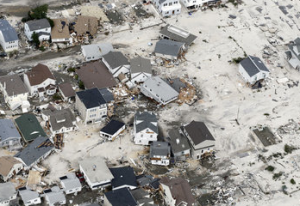 [/frame]
[/frame]
In an era of decreased budgets at every level of government the disasters caused by storms like Super Storm Sandy present us real problems. They also are causing us to be creative and to form unique partnerships. While building hard infrastructure is expensive and time consuming, partnering with nature and allowing the re-establishment of buffering wetlands may be more cost and outcome effective. Our choices may have more to do with habit than rationality.
In his November article on the Sustainable Cities Collective website Colin Cafferty discusses the value of buffering wetlands. Filling in wetlands and building close to the water has made us vulnerable to sea level rise and storms. “New York’s wetlands … are actually a key difference for the protection of the city’s citizens against future flooding disasters. Wetlands provide natural flood control by temporarily holding and absorbing floodwater, reducing the energy of storm surges and helping to control erosion of the shoreline.” Similar arguments were made following Hurricane Katrina about the impacts of the loss of gulf wetland communities.
Cafferty argues that the lack of planning and development guidance to protect these important “green or soft” infrastructures has boxed us into a difficult position. “President Obama has pledged to rebuild storm-torn neighborhoods in Queens and Staten Island – but is this really the best way forward?” The question seems to be, do we want to rebuild in ways that we know are prone to flooding and so be forced to spend more money protecting vulnerable communities or to give some of the land back to the wetlands that can absorb the storm surges and protect remaining communities? “…the cost of building storm surge gates … could cost a staggering $23 billion. Building new wetlands and restoring existing ones, which are allowed to flood and cushion residential areas and offices, is potentially a far more affordable approach.”
As Colin points out our reaction to events like this illuminate how our minds work. It reminded me of an exercise used by Harvard Business School professor Max Bazerman. In his classes he auctions off a twenty dollar bill with four rules:
1. Everyone is free to bid
2. Bids are to be made in one dollar increments
3. The winner of the auction wins the bill
4. The runner up must honor his/her bid, while receiving nothing in return
After beginning fast, furious, and fun, students begin to realize that they may end up paying 15 dollars for nothing. Very quickly only two bidders are left, trying to minimize their loss. They are bidding $21 to only lose one dollar rather than $19. The more loss adverse and prouder they are the higher the bidding will go, even though they knew at twenty dollars they could not come out ahead. In one case, the bidding stopped at 204 dollars!
We are at the point of deciding to change direction or to keep throwing good money after bad. The financial and political difficulties of planning, building, and planting for the future will be far cheaper than rebuilding for the past. The need to protect the bad decisions of the past keeps us stuck in a bidding war we cannot win. Our only hope of being regenerative is to plan and decide for the future and not the past.
See Original Posting for this article at: http://edgeregenerate.com/?p=750#more-750
Share this post!






By submitting a comment you grant Pattern Mind by Joel Glanzberg a perpetual license to reproduce your words and name/web site in attribution. Inappropriate and irrelevant comments will be removed at an admin’s discretion. Your email is used for verification purposes only, it will never be shared.